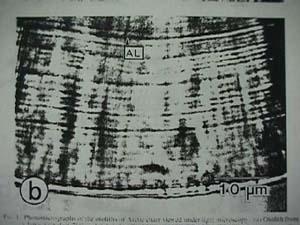4 August, 1999
Aloha from UH--Manoa, Today was a "me on my own" most of the day, as Dr.
Radtke was giving a presentation in the morning at an area hospital to
recruit students for his oceans of Potentiality program that I referred to
in the 07/30/99 journal. I spent the early morning working on my
classroom presentation ideas for before I actually go to Greenland. Any
students or teachers that have been listening in, if you would like to
have me visit your school just send an e-mail and I can visit you. I am
prepared to gear my presentation to the age level needed. There are some
great curriculum resources that I can share and activities that I can do
with students; I would love to be able to visit before (August 17),
during, and after with your classroom or group.
I finished reading another research arcticle on otoliths. This arcticle
dealt with a study Dr. Radtke and others did in Labrador, Canada. In this
study a fence was put up at the entrance to a lake, probably somewhat
like Jim Finn's weir on the Chena River in Alaska (refer to journal entry
07/14/99). They wanted to know at what age the fish migrate to saltwater,
if at all. To do this again they dissected out the otoliths. Otoliths
besides having "daily" increments, have wider bands of transparent and
opaque areas. There seems to be a correlation between the amount of food
being processed and the width of the daily incremental bands. The more
food the wider the "daily" incremental band. When viewing the whole
otolith these denser bands appear opaque and the wider bands translucent
or hyaline. Studies have been done to show that these hyaline bands are
deposited in the summer. This seems logical since food is more plentiful
in the summer months with the longer days. So now we can estimate the
years of age by counting the pairs of light and darker bands.
The study also attempted to show when and if the fish had migrated out
of the freshwater into the saltwater. To do this they used a microprobe
analysis; I will be learning the technique tomorrow and can describe it in
more detail then. The microprobe can detect the amount of Strontium (Sr)
and the amount of Calcium (Ca) in the otolith across the opaque and
hyaline bands. Why? The concentration of Strontium in seawater is greater
than in freshwater. The otolith structure can use Strontium or Calcium
interchangebly. If you look on the periodic chart you will see that
Strontium is right below Calcium; they are members of the same family.
Families on the periodic chart have similar characteristics due to their
similar atomic structure. If the fish is living and growing in seawater,
the amount of Strontium in the otolith structure will spike higher during
the microprobe analysis.
According to the study in this parcticular population of fish, most
migrate to saltwater at the age of 2-3 years during the summer months.
Interestingly they found that there were some frequent small spikes
during the 1-2 year. This may show some early foraging into saltwater, but
no long term residency for the summer.
I finshed working on my slide sandwiches for the otoliths and packed
them up for Greenland. I am sure I will remember back fondly on the ease
with which I manipulated them in the comfort of an airconditioned room at
75 F.

Picture of the otolith showing the "daily" growth increments. Note the scale is documented in the picture.

Otolith picture showing hyaline and opaque zones. Each pair indicates a year of growth.

Contact the TEA in the field at
.
If you cannot connect through your browser, copy the
TEA's e-mail address in the "To:" line of
your favorite e-mail package.
|
